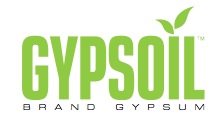News Releases
Media inquiries
Using gypsum to improve soil quality is a popular topic for farm and agricultural inflencer audiences. Please contact our communications consultant Karen Bernick at 1-866-GYPSOIL (497-7645) if you have questions, need story ideas, photos or want to set up interviews with a GYPSOIL team member. GYPSOIL also participates in many national trade shows and meetings including Ag Media Summit, Commodity Classic, National No Tillage Conference and Farm Progress show to name a few.
to improve soil quality is a popular topic for farm and agricultural inflencer audiences. Please contact our communications consultant Karen Bernick at 1-866-GYPSOIL (497-7645) if you have questions, need story ideas, photos or want to set up interviews with a GYPSOIL team member. GYPSOIL also participates in many national trade shows and meetings including Ag Media Summit, Commodity Classic, National No Tillage Conference and Farm Progress show to name a few.
High resolution photos for current news release available here.
Recorded and Powerpoint presentations from the 2014 Midwest Soil Improvement Symposium can be found on the Symposium page.
Highlights from the 2014 press conference at Ohio Farm Science Review.
A collection of general press releases can be found below:
Apply gypsum after winter wheat to improve soil

FOR IMMEDIATE RELEASE
CHICAGO, IL, (AgPR) - May 17, 2011 - Mid-summer, after wheat harvest, is the perfect opportunity to apply gypsum to improve soils.
“More and more farmers are turning to low-cost gypsum to improve soil tilth and water permeability, and to increase biological activity in the soil,” says Ron Chamberlain, director of gypsum programs for Beneficial Reuse Management, marketer of GypsoilTM brand gypsum.
“Applying gypsum to wheat stubble after harvest is ideal because it doesn’t compete with other fieldwork, equipment is available, and it gives gypsum a head start on the work it does in the soil profile,” Chamberlain says.
Gypsum is calcium sulfate dihydrate, a highly soluble compound that is carried readily into the soil profile by rainfall. It adds calcium and sulfur to the soil. Sulfur, especially, is deficient in many Midwestern soils.
Softer, healthier soils
The calcium in gypsum helps neutralize metals and chemical salts that bind with clay, causing soils to crust and clump. This can lead to ponding and erosion. Gypsum loosens the soil, improving water infiltration and reducing runoff. It also helps create a better environment for earthworms and soil microbes.
“Gypsum following wheat is almost a perfect combination for soil improvement. Wheat is a deep-rooted grass that sends organic matter and nutrients in the form of roots deep into the soil profile,” says Chamberlain. “Gypsum loosens the soil and increases the biological activity that eventually breaks down those roots and frees up the nutrients for the following crop.” Typical application rates are 1-2 tons/acre.
Gypsum is one of the oldest fertilizers used in agriculture, and is often used in home gardens. Ben Franklin was a strong advocate who recognized its benefits for crop production more than 200 years ago. However, except for certain specialty crops such as peanuts and potatoes, gypsum has not been widely used in cropping systems until recently because it is expensive to mine and transport.
But now there are new, inexpensive sources of gypsum.
Gypsoil brand gypsum is a byproduct of the process that cleans - or “scrubs” - air from coal-burning power utilities by removing sulfur dioxide (SO2) from flue gases. The resulting synthetic gypsum, sometimes called FGD (flue gas desulfurization) gypsum, has been shown to be even purer than most mined gypsum.
Due to the increased use of scrubbers, as well as the production of gypsum from other industrial processes, gypsum is now cheaper and more economical to use than in the past.
Beneficial Reuse Management (BRM) identifies byproducts of manufacturing processes that can be used in safe and effective ways to benefit land owners, conserve natural resources and preserve landfill space. BRM is rapidly building a distribution network to make Gypsoil brand gypsum widely available to Midwestern producers.
Wheat growers have an ideal opportunity to apply gypsum after mid-summer harvest because it doesn't compete with other fieldwork and it gives gypsum a head start on improving soil.


